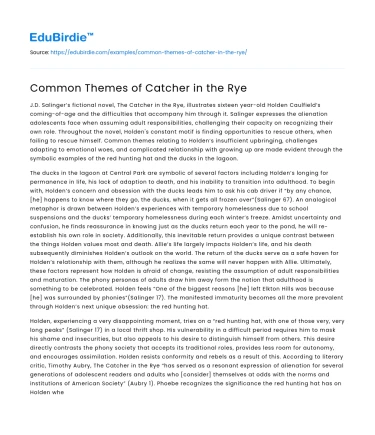J.D. Salinger’s fictional novel, The Catcher in the Rye, illustrates sixteen year-old Holden Caulfield’s coming-of-age and the difficulties that accompany him through it. Salinger expresses the alienation adolescents face when assuming adult responsibilities, challenging their capacity on recognizing their own role. Throughout the novel, Holden's constant motif is finding opportunities to rescue others, when failing to rescue himself. Common themes relating to Holden’s insufficient upbringing, challenges adapting to emotional woes, and complicated relationship with growing up are made evident through the symbolic examples of the red hunting hat and the ducks in the lagoon.
The ducks in the lagoon at Central Park are symbolic of several factors including Holden’s longing for permanence in life, his lack of adaption to death, and his inability to transition into adulthood. To begin with, Holden’s concern and obsession with the ducks leads him to ask his cab driver if “by any chance, [he] happens to know where they go, the ducks, when it gets all frozen over”(Salinger 67). An analogical metaphor is drawn between Holden’s experiences with temporary homelessness due to school suspensions and the ducks’ temporary homelessness during each winter’s freeze. Amidst uncertainty and confusion, he finds reassurance in knowing just as the ducks return each year to the pond, he will re-establish his own role in society. Additionally, this inevitable return provides a unique contrast between the things Holden values most and death. Allie’s life largely impacts Holden’s life, and his death subsequently diminishes Holden’s outlook on the world. The return of the ducks serve as a safe haven for Holden’s relationship with them, although he realizes the same will never happen with Allie. Ultimately, these factors represent how Holden is afraid of change, resisting the assumption of adult responsibilities and maturation. The phony personas of adults draw him away form the notion that adulthood is something to be celebrated. Holden feels “One of the biggest reasons [he] left Elkton Hills was because [he] was surrounded by phonies”(Salinger 17). The manifested immaturity becomes all the more prevalent through Holden’s next unique obsession: the red hunting hat.
Save your time!
We can take care of your essay
- Proper editing and formatting
- Free revision, title page, and bibliography
- Flexible prices and money-back guarantee
Holden, experiencing a very disappointing moment, tries on a “red hunting hat, with one of those very, very long peaks” (Salinger 17) in a local thrift shop. His vulnerability in a difficult period requires him to mask his shame and insecurities, but also appeals to his desire to distinguish himself from others. This desire directly contrasts the phony society that accepts its traditional roles, provides less room for autonomy, and encourages assimilation. Holden resists conformity and rebels as a result of this. According to literary critic, Timothy Aubry, The Catcher in the Rye “has served as a resonant expression of alienation for several generations of adolescent readers and adults who [consider] themselves at odds with the norms and institutions of American Society” (Aubry 1). Phoebe recognizes the significance the red hunting hat has on Holden when he wears it, accepting his true identity, not just the one he masks. She accepts both his vulnerability and pride that represents his youth by her age, still innocent, but more mature than Caulfield, as he should be.
Throughout this novel, Holden verbally expresses his fear transitioning to adulthood by exposing the hypocrisy of American society. Salinger uses symbolism throughout the novel to signify Caulfield’s regard to society with the red hunting hat’s protection and the ducks in the lagoon for his stagnation. Ultimately, they serve to signify his urge to shield children from the danger of reality and his desire to preserve his youth indefinitely which encourages his mental illnesses that he is unable to move past.






 Stuck on your essay?
Stuck on your essay?

